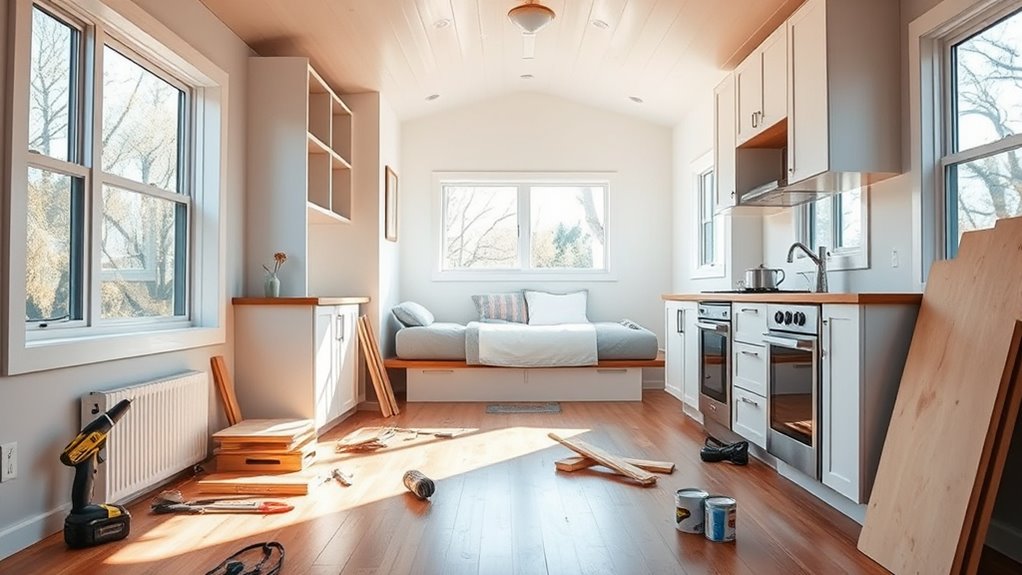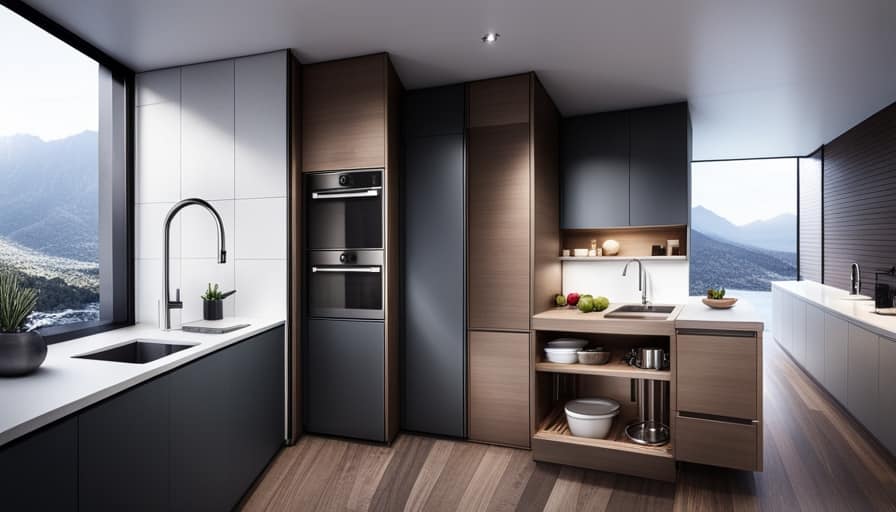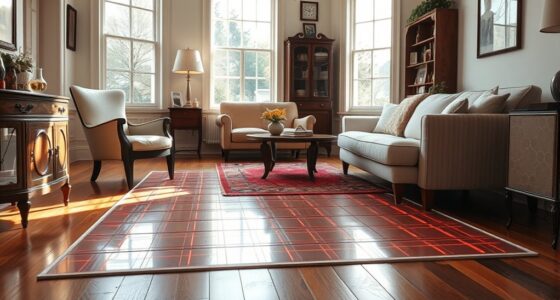To renovate a tiny home efficiently, assess your space to identify cramped areas and prioritize redesigning for better flow. Maximize storage with built-in shelves and multi-purpose furniture, and incorporate vertical solutions like wall-mounted units. Choose eco-friendly materials such as bamboo flooring and recycled tiles to enhance sustainability. Increase natural light with larger windows or skylights and use mirrors to create a sense of openness. Keep clutter minimal and embrace creative repurposing—there’s more to discover for making your tiny home truly functional and stylish.
Key Takeaways
- Evaluate and redesign the layout to maximize space and improve flow, removing unnecessary walls and adding vertical storage.
- Choose multi-purpose furniture and built-in shelves to optimize functionality and reduce clutter.
- Incorporate eco-friendly, lightweight materials like bamboo flooring and recycled tiles for durability and sustainability.
- Enhance natural light with larger windows, skylights, and strategic mirrors to make the space feel larger and more inviting.
- Focus on cost-effective, durable fixtures and creative repurposing to balance quality, style, and budget.

Renovating a tiny home can be an exciting and rewarding project, especially if you’re looking to maximize space and improve functionality. The key to success lies in smart planning and choosing the right materials. Start by evaluating your current layout and identifying areas where space feels cramped or underutilized. This step helps you prioritize which areas need redesigning and what kinds of solutions will work best. When it comes to storage, think vertically and creatively. Incorporate smart storage solutions like built-in shelves, fold-away beds, and multi-purpose furniture that can serve more than one function. These ideas not only free up floor space but also keep your home organized and clutter-free, making your small space feel more open.
Maximize space with smart storage solutions like built-ins, fold-aways, and multi-purpose furniture for a more open tiny home.
In addition, selecting eco-friendly materials during your renovation can make a significant difference. Sustainable options like bamboo flooring, recycled glass tiles, and low-VOC paints help reduce your environmental impact while creating a healthier living environment. Eco-friendly materials are often lightweight, durable, and easy to maintain, making them ideal for tiny homes. They also add aesthetic appeal, helping to create a cozy yet modern atmosphere. When choosing materials, look for products with certifications like Green Seal or FSC to ensure you’re making environmentally responsible choices. Moreover, embracing creative practice during your renovation process can inspire innovative solutions and unique design elements tailored to your space.
To make your tiny home more functional, consider ways to maximize natural light. Installing larger windows or skylights can make the space feel bigger and more inviting. Use mirrors strategically to reflect light and create the illusion of more space. Keep your layout open by removing unnecessary walls or partitions that don’t serve a crucial purpose. This approach enhances flow and allows for flexible living arrangements. When planning your renovation, keep in mind that every square inch counts, so prioritize solutions that serve multiple purposes. For example, a kitchen island with built-in storage can function as a workspace, dining area, and storage unit all in one.
Throughout the renovation process, focus on quality over quantity. Invest in durable, eco-friendly materials and fixtures that will stand the test of time. This approach reduces long-term costs and minimizes waste. Be mindful of your budget by sourcing affordable yet sustainable options, and don’t be afraid to get creative with repurposing old furniture or materials. With thoughtful planning and strategic choices, you can transform your tiny home into a stylish, functional, and eco-friendly sanctuary that maximizes every inch of space.
Frequently Asked Questions
How Can I Maximize Storage in a Tiny Home Renovation?
You can maximize storage by choosing multi-purpose furniture that serves dual functions, like beds with drawers or fold-out desks. Incorporate vertical storage solutions such as wall-mounted shelves, hanging organizers, and tall cabinets to free up precious floor space. Using these strategies, you’ll efficiently utilize every inch, making your tiny home feel spacious and organized without sacrificing style or comfort.
What Are Budget-Friendly Renovation Options for Small Spaces?
Did you know that budget-friendly renovations can save you up to 30%? To keep costs low, consider using cost-effective paint to brighten your space without overspending. DIY furniture projects also add personality and save money compared to store-bought pieces. Focus on repurposing existing items and choosing simple, versatile materials. These small changes make a big difference, helping you create a cozy, stylish home without breaking the bank.
How Do I Ensure Proper Insulation in a Tiny Home?
To guarantee proper insulation in your tiny home, start by choosing the right insulation types like spray foam, foam board, or fiberglass batts, based on your budget and climate. Use effective sealing techniques such as caulking gaps, weatherstripping doors and windows, and sealing around electrical outlets. This combination keeps your space warm and energy-efficient, making your tiny home comfortable year-round.
What Permits or Approvals Are Needed for Tiny Home Renovations?
You need to check local zoning regulations and building codes before renovating your tiny home. Contact your city or county’s planning department to find out if permits are required for modifications, plumbing, or electrical work. Obtaining these approvals guarantees your renovation complies with safety standards and avoids fines. Keep documentation of all permits to streamline inspections and future resale, making sure your tiny home renovation is both legal and efficient.
How Can I Improve Natural Lighting During Renovation?
Your tiny home can shine brighter than the sun if you boost natural lighting! Install solar skylights to flood your space with sunlight and choose light-colored walls to reflect that glow. Keep window openings unobstructed and consider adding mirrors to amplify the effect. These simple upgrades make your tiny home feel airy, open, and dramatically more inviting, transforming even the smallest space into a bright, cheerful sanctuary.
Conclusion
Renovating your tiny home can be a rewarding project if you plan carefully and stay efficient. Did you know that 78% of tiny homeowners report increased happiness after their renovations? Keep your focus on smart space utilization and budget management, and you’ll create a cozy, functional sanctuary. Remember, small spaces often bring big joys—so enjoy the process and embrace your transformed home as a reflection of your style and ingenuity.









